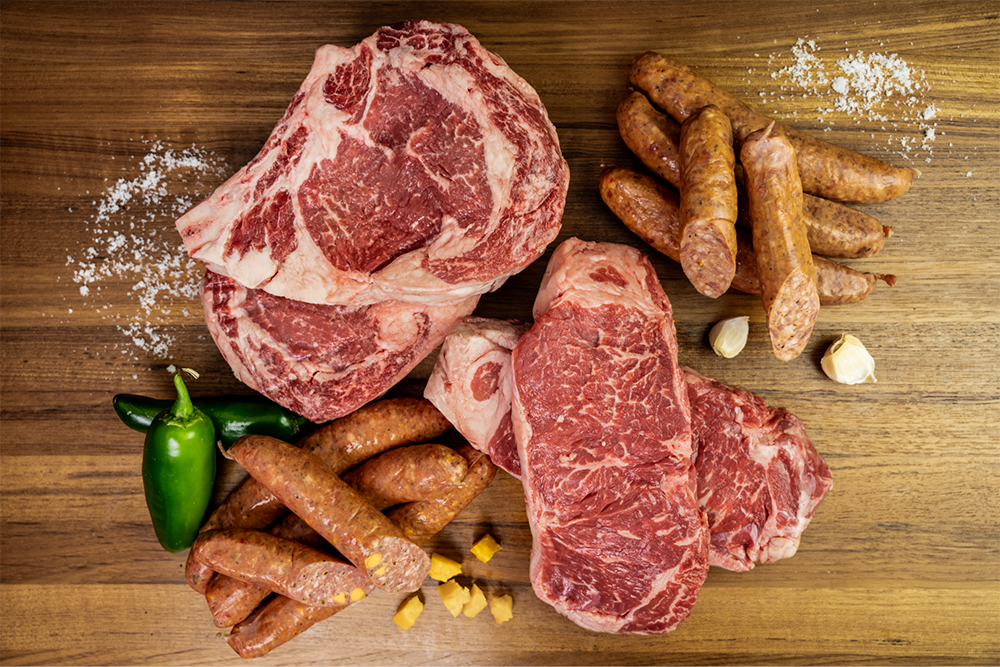Why Bagley Farms Meat Market Edwardsville IL Is the very best Choice for Top Quality Meats
Uncover the Art of the Butcher's Cut in a Modern Meat Market
In the ever-evolving landscape of modern meat markets, the butcher's cut has actually transcended its typical origins, merging old-time craftsmanship with modern practices. What absolutely sets the modern-day butcher apart is their capacity to create a much deeper connection in between consumers and the beginnings of their meat.
Evolution of Butchery Strategies

The mid-20th century saw butchery techniques additionally fine-tuned by scientific understandings right into muscle mass biology and meat aging, improving both tenderness and taste. Innovations like vacuum cleaner product packaging and refrigeration prolonged product shelf-life, enabling butchers to diversify offerings and improve top quality control. This duration likewise marked the surge of specific equipment, such as band saws and meat slicers, which increased accuracy and effectiveness in meat handling.
Electronic systems currently help in monitoring animal provenance and maximizing cuts to satisfy details client choices. In addition, a renewal in artisanal butchery has emerged, mixing conventional abilities with modern understanding to provide to consumers looking for honest and lasting meat options.

Understanding Meat Cuts

Understanding the complexities of meat cuts is vital for both butchers and consumers seeking quality and worth. Each cut originates from a various part of the animal, imparting distinct flavors, structures, and food preparation techniques. Mastery of these distinctions not just improves culinary experiences but also optimizes the utility of each carcass. For butchers, accurate cuts mirror ability and respect for the craft, ensuring marginal waste and ideal yield.
The primary groups of meat cuts include primitive, sub-primal, and retail cuts. Primal cuts, such as the loin, rib, and chuck, are the huge sections at first divided from the carcass. Butchers then damage these down even more right into sub-primal cuts, before ultimately creating retail cuts offered to consumers, like ribeye or tenderloin. Each phase requires cautious attention to physiological framework and muscle mass make-up.
Comprehending muscle structure is crucial; muscle mass made use of much more often by the pet tend to be harder and are best suited for sluggish food preparation methods, while less-used muscles, like those discovered in the loin, are extra tender and ideal for barbecuing or roasting. Knowledge with More Info these distinctions encourages customers to make informed selections, enhancing their culinary endeavors.
Choosing Top Quality Meat
Picking the appropriate meat involves greater than simply selecting an aesthetically enticing item from the display screen. The art of picking top quality meat calls for a critical eye and expertise of details features that indicate quality and quality. Pay focus to the shade; beef must have a brilliant, cherry-red hue, while lamb should show a soft pink tone, and pork a light pink. This suggests the meat is fresh and hasn't been exposed to oxygen for too lengthy.
Second of all, take into consideration the marbling, which refers to the white flecks of fat within the muscular tissue. Appropriate marbling is an essential indicator of inflammation and flavor, as it melts throughout food preparation, enhancing the meat's juiciness. Bear in mind, higher marbling typically correlates with exceptional high quality cuts, such as USDA Prime.
Texture is an additional important element; meat needs to feel firm to the touch, not slimed or overly soft. In addition, be mindful of the aroma. Fresh meat ought to have a tidy, neutral odor, without any kind of sour or repulsive odors.
Coupling Cuts With Food Preparation Methods
Effectively combining cuts of meat with the ideal cooking methods is vital for attaining optimum taste click this site and appearance. These techniques improve the meat's natural flavors and make sure a juicy coating.
Conversely, harder cuts like brisket and chuck roast are rich in collagen, which breaks down into gelatin when cooked gradually. These cuts are excellent for braising or sluggish roasting, permitting the meat to soften gradually and establish deep, complicated flavors. Similarly, cuts such as brief ribs and pork shoulder fare well with slow-cooking methods, where expanded cooking times transform their robust textures right into succulent dishes.
Lamb shanks and oxtail, which require extended food preparation to tenderize, are excellent candidates for stewing or slow simmering. These methods coax out abundant, passionate flavors while maintaining moisture. By recognizing the one-of-a-kind features of each cut, chefs and home cooks alike can boost their cooking developments, guaranteeing each dish is both pleasing and unforgettable.
The Butcher's Function Today
Navigating the advancing landscape of the contemporary meat market, the butcher's duty today extends past mere prep work of cuts. Contemporary butchers are cooking artisans, instructors, and advocates for sustainable techniques.
In addition to crafting specific cuts, butchers now involve directly with clients, supplying cooking guidance and customizing selections to fit specific needs and preferences. Their knowledge in meat aging, marbling, and taste profiles equips customers to make enlightened decisions, improving their cooking experiences. This personalized service exhibits the butcher's advancing role as a trusted expert in the cooking area.
Furthermore, butchers are essential in decreasing waste, utilizing whole animals to produce varied items such as sausages and stocks - bagley farms meat market edwardsville il. This extensive technique not just values the pet but also lines up with contemporary sustainability objectives. This way, the modern-day butcher embodies both tradition and development, adapting to an ever-changing market while protecting the virtuosity and integrity of their craft

Conclusion
The modern butcher's craft intricately weaves standard methods with contemporary technologies, highlighting lasting methods and moral sourcing. Mastery in understanding diverse meat cuts more information and quality indications encourages butchers to give enlightened suggestions, aligning certain cuts with ideal food preparation techniques. This knowledge not just raises culinary experiences however also reinforces the connection in between consumers and the beginnings of their food. By honoring historical techniques while accepting modern demands, the butcher's duty remains essential in today's sophisticated meat market.